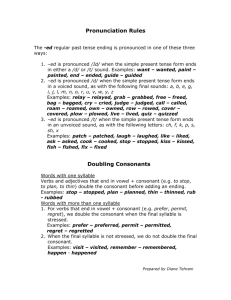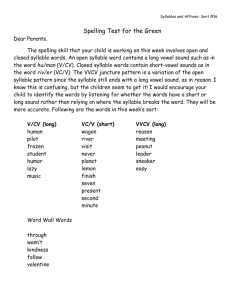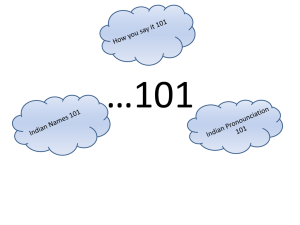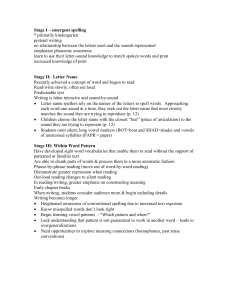Medical Terminology Study Guide
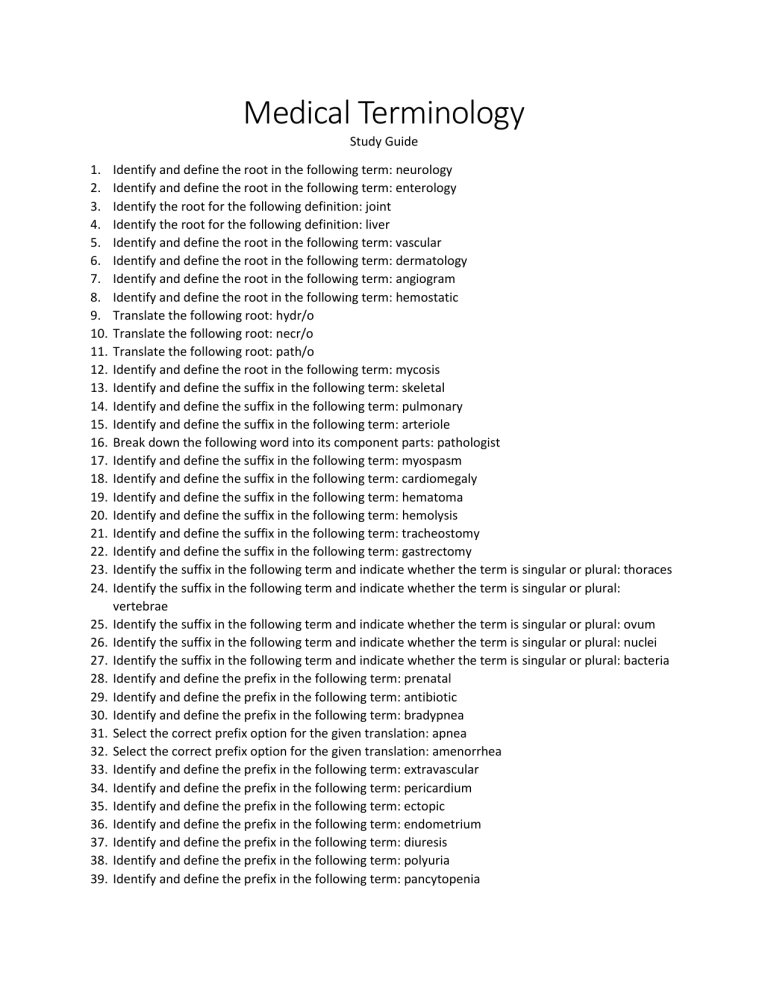
Medical Terminology
Study Guide
1.
Identify and define the root in the following term: neurology
2.
Identify and define the root in the following term: enterology
3.
Identify the root for the following definition: joint
4.
Identify the root for the following definition: liver
5.
Identify and define the root in the following term: vascular
6.
Identify and define the root in the following term: dermatology
7.
Identify and define the root in the following term: angiogram
8.
Identify and define the root in the following term: hemostatic
9.
Translate the following root: hydr/o
10.
Translate the following root: necr/o
11.
Translate the following root: path/o
12.
Identify and define the root in the following term: mycosis
13.
Identify and define the suffix in the following term: skeletal
14.
Identify and define the suffix in the following term: pulmonary
15.
Identify and define the suffix in the following term: arteriole
16.
Break down the following word into its component parts: pathologist
17.
Identify and define the suffix in the following term: myospasm
18.
Identify and define the suffix in the following term: cardiomegaly
19.
Identify and define the suffix in the following term: hematoma
20.
Identify and define the suffix in the following term: hemolysis
21.
Identify and define the suffix in the following term: tracheostomy
22.
Identify and define the suffix in the following term: gastrectomy
23.
Identify the suffix in the following term and indicate whether the term is singular or plural: thoraces
24.
Identify the suffix in the following term and indicate whether the term is singular or plural: vertebrae
25.
Identify the suffix in the following term and indicate whether the term is singular or plural: ovum
26.
Identify the suffix in the following term and indicate whether the term is singular or plural: nuclei
27.
Identify the suffix in the following term and indicate whether the term is singular or plural: bacteria
28.
Identify and define the prefix in the following term: prenatal
29.
Identify and define the prefix in the following term: antibiotic
30.
Identify and define the prefix in the following term: bradypnea
31.
Select the correct prefix option for the given translation: apnea
32.
Select the correct prefix option for the given translation: amenorrhea
33.
Identify and define the prefix in the following term: extravascular
34.
Identify and define the prefix in the following term: pericardium
35.
Identify and define the prefix in the following term: ectopic
36.
Identify and define the prefix in the following term: endometrium
37.
Identify and define the prefix in the following term: diuresis
38.
Identify and define the prefix in the following term: polyuria
39.
Identify and define the prefix in the following term: pancytopenia
40.
Identify and define the prefix in the following term: dysuria
41.
Identify and define the prefix in the following term: euthyroid
42.
Identify and define the root in the following term: osteitis
43.
Identify and define the root in the following term: arthralgia
44.
Identify and define the root in the following term: hepatectomy
45.
Identify and define the suffix in the following term: hepatectomy
46.
Select the correct answer: The S in SOAP stands for
47.
Select the correct answer: The O in SOAP stands for
48.
Select the correct answer: The A in SOAP stands for
49.
Select the correct answer: The P in SOAP stands for
50.
A SOAP note is:
51.
A differential diagnosis is:
52.
A diagnosis is:
53.
Identify the part of the SOAP note in which the following information would be found: past medical history, family history
54.
Identify the part of the SOAP note in which the following information would be found: treatment with medicine
55.
Identify the part of the SOAP note in which the following information would be found: lab results
56.
Identify the part of the SOAP note in which the following information would be found: initial imaging studies
57.
Identify the part of the SOAP note in which the following information would be found: the patient's exam
58.
Which health record does NOT follow the SOAP format?
59.
Select the health records that document a type of procedure:
60.
In a problem-based approach, you:
61.
Identify the author of this type of health record: pathology report
62.
Identify the author of this type of health record: radiology report
63.
Indicate which syllable receives emphasis when pronounced: lethargic
64.
Indicate which syllable receives emphasis when pronounced: febrile
65.
Indicate which syllable receives emphasis when pronounced: palpation
66.
Indicate which syllable receives emphasis when pronounced: malignant
67.
Indicate which syllable receives emphasis when pronounced: systemic
68.
Indicate which syllable receives emphasis when pronounced: morbidity
69.
Indicate which syllable receives emphasis when pronounced: mortality
70.
Indicate which syllable receives emphasis when pronounced: pathogen
71.
Indicate which syllable receives emphasis when pronounced: prognosis
72.
Indicate which syllable receives emphasis when pronounced: proximal
73.
Indicate which syllable receives emphasis when pronounced: distal
74.
Indicate which syllable receives emphasis when pronounced: ventral
75.
Indicate which syllable receives emphasis when pronounced: dorsal
76.
Indicate which syllable receives emphasis when pronounced: dorsum
77.
Indicate which syllable receives emphasis when pronounced: plantar
78.
Indicate which syllable receives emphasis when pronounced: palmar
79.
Indicate which syllable receives emphasis when pronounced: coronal
80.
Indicate which syllable receives emphasis when pronounced: transverse
81.
Select the correct answer: The impression of appendicitis is considered which part of a SOAP note?
82.
Select the correct answer: The abbreviation Sig means:
83.
Translate the following root: adip/o
84.
Translate the following root: dermat/o
85.
Translate the following root: trich/o
86.
Translate the following root: erythr/o
87.
Build a medical term from the information provided: inflammation of the skin
88.
Build a medical term from the information provided: nail disease
89.
Identify the root(s) for the following definition: black (1 root)
90.
Identify the root(s) for the following definition: yellow (1 root)
91.
Build a medical term from the information provided: white skin
92.
Indicate which syllable receives emphasis when pronounced: albinism
93.
Indicate which syllable receives emphasis when pronounced: erythema
94.
Indicate which syllable receives emphasis when pronounced: pruritus
95.
Indicate which syllable receives emphasis when pronounced: urticaria
96.
In the first drop down box, select the root in the following term: dermatalgia
97.
In the first drop down box, select the root in the following term: onychophagia
98.
In the first drop down box, select the root in the following term: hyperhidrosis
99.
In the first set of drop down boxes, select the first root in the term and the correct definition for that root: erythroderma
100.
Build a medical term from the information provided: skin pain
101.
Pruritus describes:
102.
Indicate which syllable receives emphasis when pronounced: pustule
103.
Indicate which syllable receives emphasis when pronounced: ecchymosis
104.
Indicate which syllable receives emphasis when pronounced: verucca
105.
Indicate which syllable receives emphasis when pronounced: keratosis
106.
In the first drop down box, select the root in the following term: epidermal tumor
107.
In the first drop down box, select the root in the following term: onychomalacia
108.
Build a medical term from the information provided: nail disease
109.
What terms refer to flat, nonpalpable lesions:
110.
Which elevated, fluid-filled lesion is pus-filled?
111.
What terms refer to scar formation:
112.
Which diagnostic procedure involves growing microorganisms:
113.
Select the root in the following term: dermatomycosis
114.
Acne vulgaris means:
115.
Impetigo is a:
116.
A bed sore is a(n):
117.
Eczema is:
118.
Indicate which syllable receives emphasis when pronounced: antihistamine
119.
Select the root in the following term: onychectomy
120.
Select the root in the following term: epidermal
121.
Select the root in the following term: subcutaneous
122.
Define the following abbreviation: derm
123.
Define the following abbreviation: ID
124.
Define the following abbreviation: ABCDE
125.
Give the abbreviation for the following definition: biopsy
126.
Give the abbreviation for the following definition: culture and sensitivity
127.
Match the definition on the left to the abbreviation on the right.
128.
Identify the correct pronunciation for the underlined syllables: myodynia
129.
Identify the correct pronunciation for the underlined syllable: hypotonia
130.
Identify the correct pronunciation for the underlined syllable: arthrodynia
131.
Translate the following word part: crani/o
132.
Translate the following word part: kinesi/o
133.
Translate the following word part: cervic/o
134.
Translate the following word part: -paresis
135.
What term means abnormal joint development?
136.
What joint condition is caused by infection?
137.
What condition is characterized by poor muscle development?
138.
What condition is characterized by the loss of muscle control?
139.
What procedure uses screws, pins, plates, and so on to fix a fracture?
140.
Break down the following word into its component parts: tendinitis
141.
Break down the following word into its component parts: sternotomy
142.
Break down the following word into its component parts: craniectomy
143.
Break down the following word into its component parts: chondrectomy
144.
Break down the following word into its component parts: bursolith
145.
Break down the following word into its component parts: ostalgia
146.
Break down the following word into its component parts: costochondritis
147.
Select the root in the following term: arthralgia
148.
Select the root in the following term: ostealgia
149.
Select the root in the following term: osteectomy
150.
Select the root in the following term: tendectomy
151.
Select the root in the following term: fasciotomy
152.
Select the root in the following term: bursotomy
153.
Select the root in the following term: antiarthritic
154.
Select the first root in the term and the correct definition for that root: myofasciitis
155.
Select the root in the following term: osteomyelitis
156.
Select the root in the following term: polydactyly
157.
Select the root in the following term: achondroplasia
158.
Select the root in the following term: spondylolisthesis
159.
Identify the term for the following definition: ankle
160.
Identify the term for the following definition: arm
161.
Identify the term for the following definitions: stiff, bent
162.
Identify the term for the following definition: growth
163.
Build a medical term from the information provided: removal of a joint
164.
Build a medical term from the information provided: tumor-like growth of cartilage tissue
165.
Build a medical term from the information provided: softening of bone
166.
Build a medical term from the information provided: removal of a portion of the skull
167.
Build a medical term from the information provided: incision into a tendon
168.
Build a medical term from the information provided: record of the electrical activity of a muscle
169.
Build a medical term from the information provided: joint stiffness
170.
Translate the following word part: cerebr/o
171.
Translate the following word part: encephal/o
172.
Translate the following word parts: mening/o, meningi/o
173.
Break down the following word into its component parts: epidural
174.
Break down the following word into its component parts: craniotomy
175.
Break down the following word into its component parts: encephalopathy
176.
Break down the following word into its component parts: dystonia
177.
Break down the following word into its component parts: aphasia
178.
Break down the following word into its component parts: neurasthenia
179.
Select the root in the following term: encephalocele
180.
Select the root (word part) in the following term: schizophrenia
181.
Select the root (word part) in the following term: somnambulism
182.
Break down the following word into syllables: paresthesia
183.
Indicate which syllable receives emphasis when pronounced: aphasia
184.
Indicate which syllable receives emphasis when pronounced: insomnia
185.
Break down the following word into its component parts: synesthesia
186.
Select the root in the following term: dysesthesia
187.
Select the root in the following term: aphasia
188.
Indicate which syllable receives emphasis when pronounced: agnosia
189.
Select the root in the following term: agnosia
190.
Select the root in the following term: prosopagnosia
191.
Name three terms that apply to seizures:
192.
Select the correct answer: During a lumbar puncture (LP), the needle is inserted into what part of the body?
193.
Select the correct answer: A person with prosopagnosia cannot
194.
Select the root in the following term: craniomalacia
195.
Select the root in the following term: craniosynostosis
196.
Select the correct answer: Anorexia is
197.
Select the correct answer: The common name for this disease is Lou Gehrig’s disease.
198.
Select the root in the following term: epidural
199.
Select the correct answer: The root trope in the term psychotropic means
200.
Define the following abbreviation: MS
201.
Define the following abbreviation: ALS
202.
Define the following abbreviation: PNS
203.
Select the correct answer: Photophobia is defined as
204.
Select the correct answer: A transient ischemic attack is caused by
205.
Translate the following word part: -phobia
206.
Break down the following word into syllables: encephalalgia
207.
Break down the following word into its component parts: pseudesthesia
208.
Break down the following word into its component parts: dyslexia



